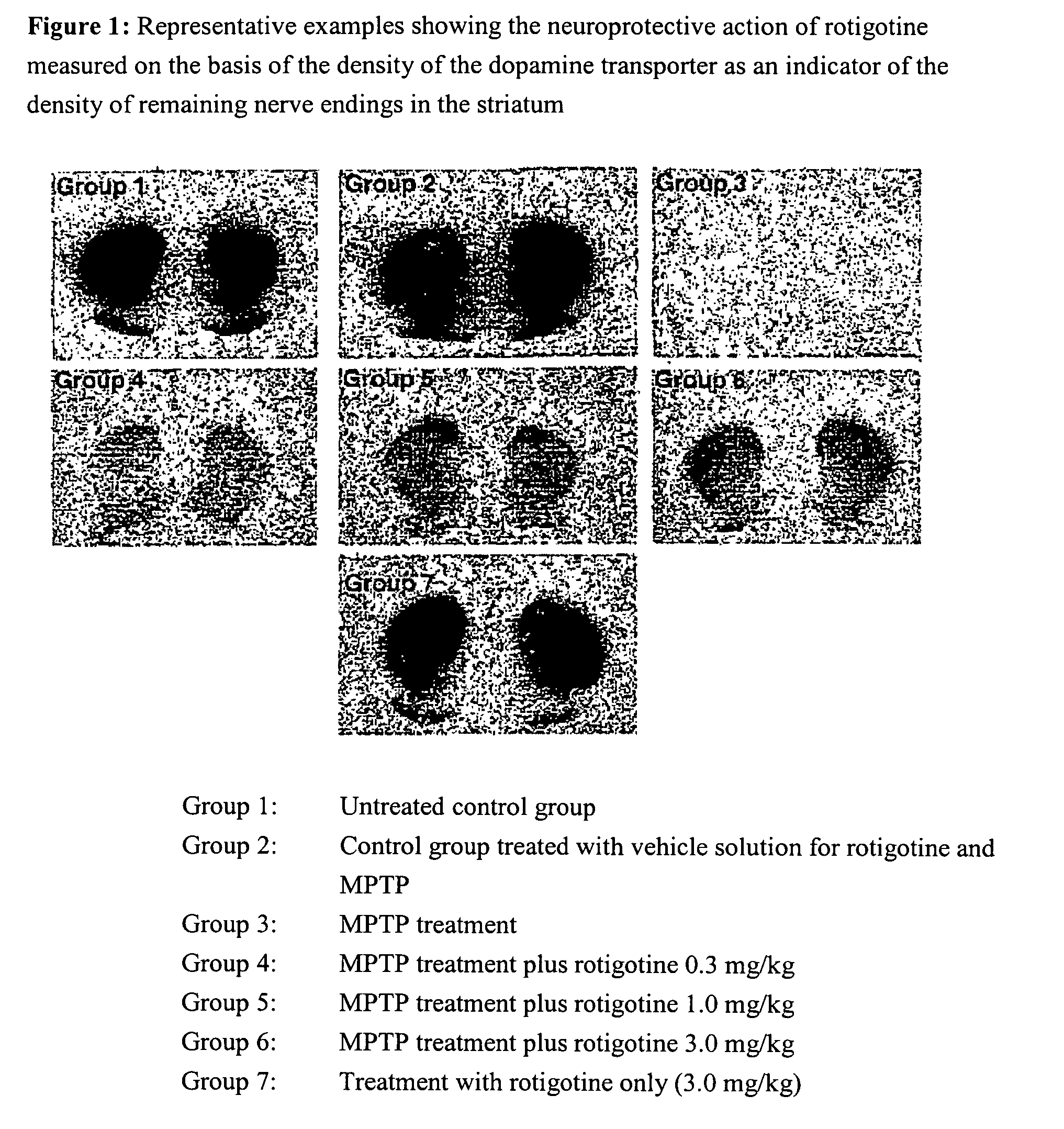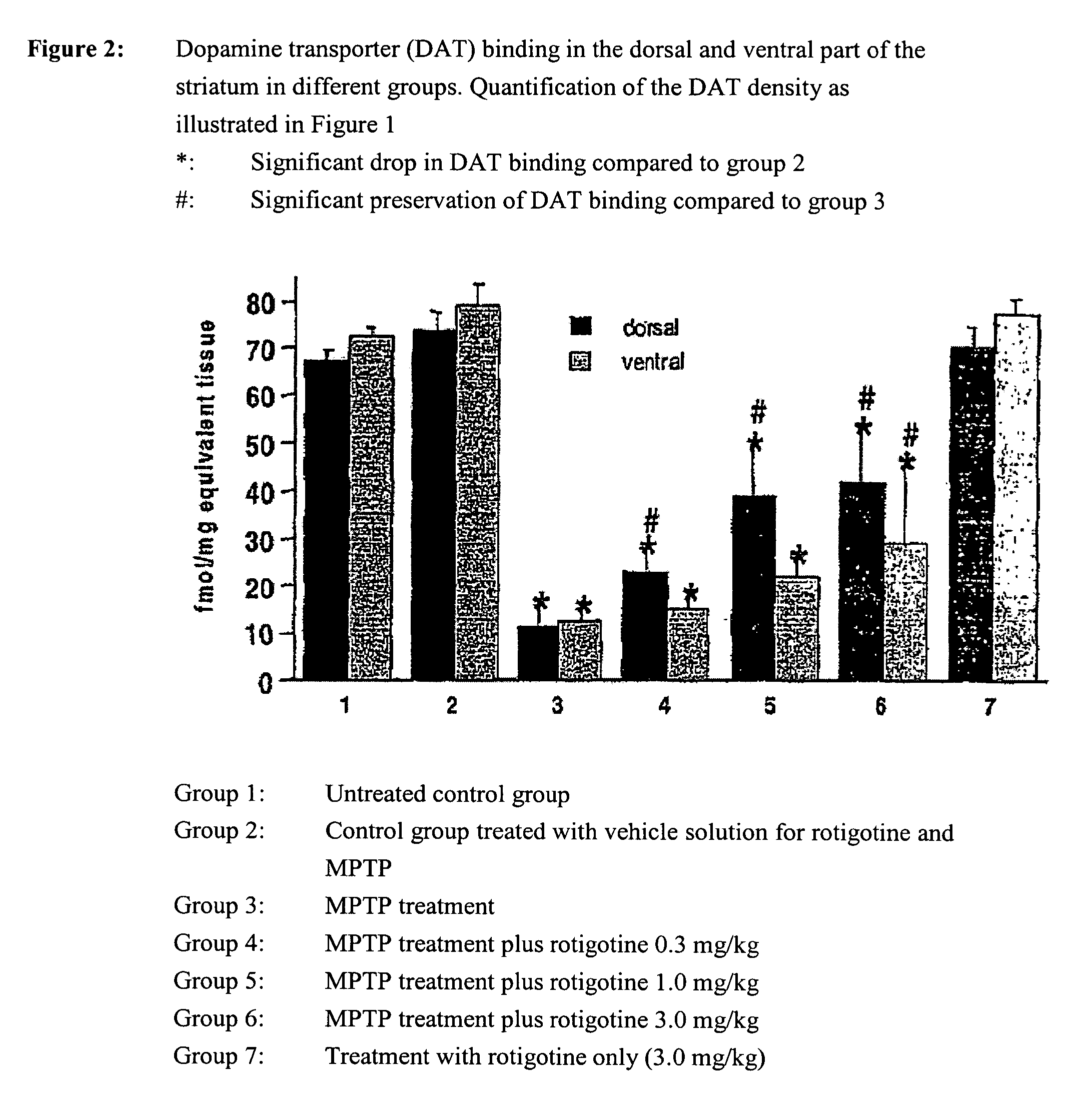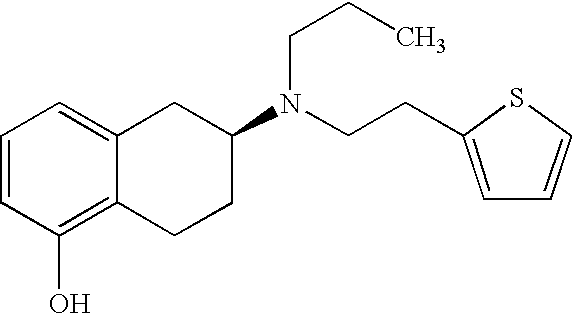Use of rotigotine for treating and preventing Parkinson's plus syndrome
a technology of parkinson's plus and rotigotine, which is applied in the direction of heterocyclic compound active ingredients, biocides, drug compositions, etc., can solve the problems of difficult drug treatment of pps and general ineffective treatment effect of dopamine receptor agonists, so as to prevent or reduce the progression rate of dopaminergic cell loss
- Summary
- Abstract
- Description
- Claims
- Application Information
AI Technical Summary
Benefits of technology
Problems solved by technology
Method used
Image
Examples
embodiments
1st Embodiment: Rotigotine Plasters
[0078]1.8 g rotigotine (free base) were dissolved in 2.4 g ethanol and added to 0.4 g Kollidon 90F (dissolved in 1 g ethanol). This mixture was added to a 74% solution of silicone polymers (8.9 g BioPSA 7-4201+8.9 g BIO-PSA 7-4301 [Dow Corning]) in heptane. After the addition of 2.65 g petroleum ether, the mixture was agitated for 1 hour at 700 rpm to obtain a homogeneous dispersion. After lamination on polyester, it was dried at 50° C. The final weight of the plaster was 50 g / cm2.
2nd embodiment
ot Suspensions
[0079]1411.2 g Miglyol 812 were weighed in a Duran flask. 14.4 g Imwitor 312 were added to the Miglyol and then heated for 30 minutes under agitation to 80° C. The clear solution was cooled to room temperature and filtered.
[0080](b) 1188 g of the solution produced in (a) were transferred to a glass laboratory reactor, 12 g rotigotine HCl added and homogenised for 10 minutes with an Ultraturrax at 10000 rpm under nitrogen. The suspension was filled into brown glass flasks with a running Ultraturrax (2000 rpm).
3rd embodiment
Model
[0081]To induce intoxication, mice were administered 80 mg / kg of the neurotoxin 1-methyl-4-phenyl-1,2,3,6-tetrahydro-pyridine (MPTP) (in portions of 20 mg / kg in two-hourly intervals, groups 3-6 in FIGS. 1 and 2) resulting in the degeneration of about 50-60% of the neurons of the substantia nigra (maximum degeneration in group 3 in FIGS. 1 and 2). Rotigotine was administered daily in doses of 0.3, 1 or 3 mg / kg respectively over 7 days as a so-called ‘slow-release formulation’ (see embodiment 2) (groups 4-6 in FIGS. 1 and 2). A group of MPTP-treated animals (group 3) was given rotigotine-vehicle solution (see embodiment 2 without rotigotine HCl) and served as a reference. The controls were groups 1, 2 and 7, whereby group 1 is not given any treatment, group 2 is treated with the vehicle-solutions for MPTP and rotigotine, and group 7 was exclusively given rotigotine. The animals were sacrificed on day 8, their brains removed and frozen. Frozen sections were incubated with 100 pm[1...
PUM
| Property | Measurement | Unit |
|---|---|---|
| concentrations | aaaaa | aaaaa |
| concentrations | aaaaa | aaaaa |
| concentrations | aaaaa | aaaaa |
Abstract
Description
Claims
Application Information
 Login to View More
Login to View More - R&D
- Intellectual Property
- Life Sciences
- Materials
- Tech Scout
- Unparalleled Data Quality
- Higher Quality Content
- 60% Fewer Hallucinations
Browse by: Latest US Patents, China's latest patents, Technical Efficacy Thesaurus, Application Domain, Technology Topic, Popular Technical Reports.
© 2025 PatSnap. All rights reserved.Legal|Privacy policy|Modern Slavery Act Transparency Statement|Sitemap|About US| Contact US: help@patsnap.com



